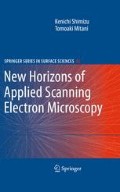Abstract
A further advantage of the use of ultramicrotomy for cross-sectional examination of various coatings on metals of industrial importance is demonstrated here by examination of an anodized aluminum alloy for aerospace application. The surface of anodized alloy is shown in Fig. E12.1a. It is evident that the anodized alloy surface is highly complex and heterogeneous; relatively large craters of sizes, up to 10 μm, are observed either in isolation or in clusters of a few to several features. Networks of crevices are also observed. Fig. E12.1b shows the cross-section of the anodized alloy. A clean and highly flat cross-section was exposed by ultramicrotomy using a diamond knife and examined in the in-lens SE imaging mode at an accelerating voltage of 0.76kV to avoid charging. Further, the specimen was tilted at ~20° to the incident electron beam such that the area beyond the exposed cross-section can be examined simultaneously. Anodic film is observed as a darker band of material over the alloy substrate which exhibits a lighter contrast. The anodic film/alloy interface is not flat like that of a similar film grown over an electropolished high-purity aluminum specimen. It appears that the film grows to fill the cavities left by selective dissolution of coarse intermetallic phases. At local regions, where craters are present, local film morphology is highly complex, as shown in Fig. E12.1c. Understanding of such complex film morphology which, in turn, is related to local filming behavior associated with the presence of intermetallic phases is assisted greatly by simultaneous examination of regions beyond the exposed cross-section. This, among other things, is the distinct advantage of the present approach over TEM examination of thin cross-sectional slices of similar specimens, prepared, for example, by FIB where information is limited only within the “thickness of slices.”
Access this chapter
Tax calculation will be finalised at checkout
Purchases are for personal use only
Author information
Authors and Affiliations
Corresponding author
Rights and permissions
Copyright information
© 2010 Springer-Verlag Berlin Heidelberg
About this chapter
Cite this chapter
Shimizu, K., Mitani, T. (2010). Application Example 12: Cross-Sectional Examination of an Anodized Aluminum Alloy for Aerospace Application. In: New Horizons of Applied Scanning Electron Microscopy. Springer Series in Surface Sciences, vol 45. Springer, Berlin, Heidelberg. https://doi.org/10.1007/978-3-642-03160-1_13
Download citation
DOI: https://doi.org/10.1007/978-3-642-03160-1_13
Published:
Publisher Name: Springer, Berlin, Heidelberg
Print ISBN: 978-3-642-03159-5
Online ISBN: 978-3-642-03160-1
eBook Packages: Chemistry and Materials ScienceChemistry and Material Science (R0)

